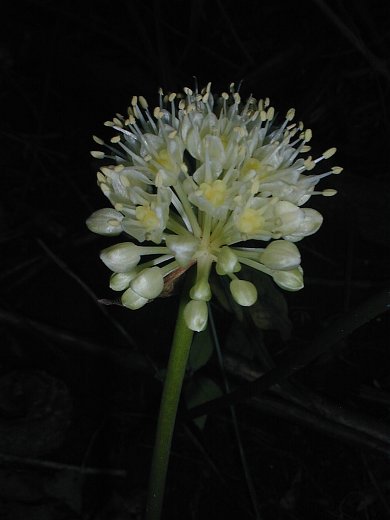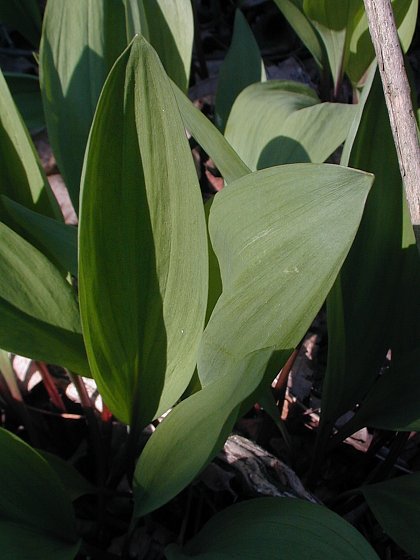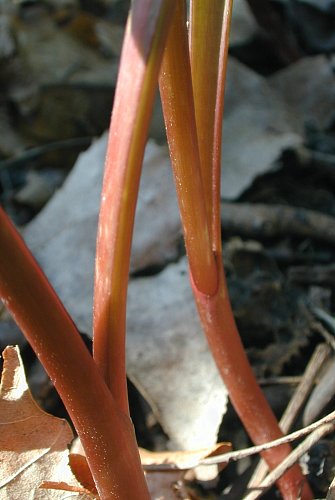Description: This herbaceous perennial plant produces basal leaves 4-9" long and 1½-3½" across on short petioles (usually 2-3 per bulb). The basal leaves are ovate-oval to ovate-elliptic, light to medium green, hairless, and smooth along the margins. Their petioles are reddish, hairless, and wrapped in a basal sheath below. These leaves develop during the spring and wither away by early summer. During early to mid-summer, there develops a naked flowering stalk about ½-1½' tall. This stalk is terete, glabrous, and reddish to pale green; at its base, there is a papery sheath. The stalk terminates in a single rounded umbel of flowers spanning 1-2" across; there are typically 20-40 flowers per umbel. At the base of this umbel, there is a pair of deciduous bracts. Each flower is about ¼" across, consisting of 6 white to translucent white tepals, a light green to pale yellow ovary, 6 stamens with pale yellow anthers, and a single white style. At the base of each flower, there is a slender pedicel that is white to greenish white. The blooming period occurs during the summer and lasts about 2 weeks. Both the flowers and foliage exude an onion-like odor. After the blooming period, the ovary of each flower matures into a 3-celled seed capsule; each cell contains a single globoid seed that becomes black at maturity. The root system consists of an ovoid bulb with fibrous roots at its base. Offsets often develop, producing clonal colonies of plants.

Cultivation:
The
preference is dappled sunlight during the spring when the basal leaves
develop, while during the summer considerable shade is tolerated as the
basal leaves have withered away. The
soil should consist of a rich loose loam with abundant organic matter,
while moisture levels should be more or less mesic. It is easiest to
introduce new plants into an area by dividing and transplanting the
bulbs during the fall.
Range & Habitat:
The native Wild Leek occurs occasionally in central and
northern Illinois,
while in the southern section of the state it is rare or
absent
(see Distribution
Map). Habitats include mesic deciduous woodlands and wooded
bluffs. The presence of this species is a sign that the original flora
of a woodlands is still in intact. An introduced species, Alliaria
petiolata (Garlic Mustard), can shade out the basal leaves of
Wild Leek during the spring, causing the latter to decline in abundance.

Faunal
Associations:
The flowers attract various kinds of bees, including Halictid bees,
masked bees (Hylaeus spp.), honeybees, bumblebees, and mason bees.
These insects suck nectar or collect pollen. To a lesser extent, the
flowers are visited by Syrphid flies, which suck nectar or feed on
pollen. Occasionally, the maggots of some flies feed on the bulbs of
some Allium spp. (Onions), although not necessarily
Wild Leek; these species include Delia
antiqua (Onion Maggot), some Eumerus spp., and
some Tritoxa spp.
The plant bugs, Lindbergocapsus
ainsliei and Lindbergocapsus
allii, also feed on Allium
spp. (Onions). Another species, Thrips tabaci
(Onion Thrips), sucks juices from the foliage. Deer and other mammalian
herbivores rarely browse on the foliage of Wild Leek.
Photographic Location:
A mesic deciduous woodlands at Busey Woods in Urbana, Illinois.

Comments: This woodland wildflower is somewhat unusual because its foliage has withered away by the time the flowers bloom. Both the foliage and flowers are attractive; the latter help to brighten the gloomy corners of woodlands during the summer. Wild Leek has the widest basal leaves (1½–3½" across) of any Allium sp. in the state. A similar species, Allium burdickii (which is also called 'Wild Leek'), has basal leaves that are about ½-1½" across. Other wild Allium spp. have leaves that are narrow and strap-like (less than ½" across). Wild Leek has about 20-40 flowers in each umbel, while Allium burdickii has 10-20 flowers in each umbel. Wild Leek has reddish leaf petioles and flowering stalks that are often reddish at the base, while the petioles and stalks of Allium burdickii are light green throughout. This latter species is restricted to wooded areas in NE Illinois and it is less common.